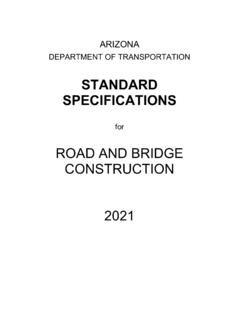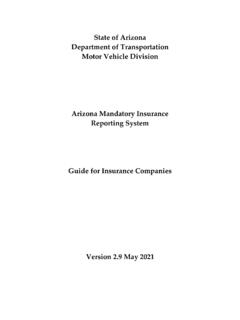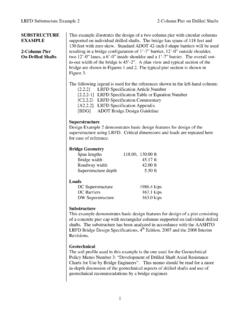Transcription of Temporary Traffic Control Design Guidelines
1 Arizona Department of Transportation Temporary Traffic Control Design Guidelines Traffic Engineering Group September 2019 Temporary Traffic Control Design Guidelines i Contents Introduction .. 1 Fundamental Principles .. 1 Speed Limits Within Work Zones .. 2 Components of Temporary Traffic Control .. 4 Advance Warning Area .. 4 Tapers .. 4 One Lane, Two Way Traffic Control .. 4 Temporary Traffic Control Elements .. 5 Crash Test Requirements for Temporary Traffic Control Devices .. 5 Signs .. 5 Smart Work Zone Systems .. 5 Channelizing Devices .. 5 Temporary Concrete Barrier (TCB).
2 7 Other Barriers .. 8 Temporary Pavement Markings .. 8 Temporary Pavement Markers .. 9 Temporary Delineators .. 9 Changeable Message 9 Temporary Impact Attenuators .. 10 Temporary In Line Attenuators (In Line Energy Absorbing Terminals) .. 10 Truck Mounted Attenuators .. 10 Temporary Traffic Signals (Portable) .. 11 Warning Lights .. 12 Types of Temporary Traffic Control Zone Activities .. 13 Duration of Work .. 13 Elevation Differences .. 14 Elevation Difference Signs .. 14 Supplemental Applications .. 14 Temporary Traffic Control Design Guidelines ii Appendix Traffic Control Typical.
3 A1 A27 List of Abbreviations AASHTO .. American Association of State Highway and Transportation Officials ADA .. Americans with Disabilities Act ADOT .. Arizona Department of Transportation MASH .. Manual for Assessing Safety Hardware MOAS .. Manual of Approved Signs mph .. Miles Per Hour MUTCD .. Manual on Uniform Traffic Control Devices NCHRP 350 .. National Cooperative Highway Research Program Report 350 prowag .. Pedestrian Right of Way accessibility Guidelines RDG .. Roadside Design Guide SA .. Supplemental Application TA .. Typical Application TCB .. Temporary Concrete Barrier TMP.
4 Transportation Management Plan TTC .. Temporary Traffic Control Temporary Traffic Control Design Guidelines iii Glossary Existing Speed Limit The maximum or minimum speed applicable to a section of highway as established by law or regulation prior to the implementation of Traffic Control . TTC Zone An area of a highway where road user conditions are changed because of a work zone or incident by the use of Temporary Traffic Control devices, flaggers, uniformed law enforcement officers, or other authorized personnel. Temporary Traffic Control Design Guidelines 1 Introduction This document is intended to provide Guidelines relating to the Design of Temporary Traffic Control for state highway construction, maintenance related operations, utility operations, and incident management operations.
5 The Guidelines should be used with the Manual on Uniform Traffic Control Devices (Current Edition with Arizona Supplement) (MUTCD), Arizona Department of Transportation (ADOT) Standard Specifications, and ADOT Stored Specifications. This is not a standalone document. Work activities including roadway construction, maintenance operations, utility work, and incident management operations are often unique and require a site specific plan for each situation encountered. While the MUTCD provides the foundation and the basis for the application and use of Traffic Control devices, this Design guide is intended to provide additional guidance to designers, field construction and maintenance personnel, and contractors in establishing and implementing safe, efficient, well conceived Traffic Control plans.
6 This Design guide should be used as an extension of the MUTCD in the day to day implementation of the MUTCD standards. It is the intent of this document to provide additional information which is applicable specifically to the practices, policies, and procedures currently being implemented on the Arizona State Highway System. If for any reason information presented in this document can be interpreted as conflicting with the MUTCD, the contents of the MUTCD shall take precedence and shall govern the Design or application of the standard. The Typical Applications (TA) contained in the MUTCD, in general, apply to most construction and maintenance projects.
7 Additional Supplemental Application (SA) figures are provided herein for those applications which are encountered frequently for work on State highways and are not adequately addressed in the MUTCD. If there are any conflicts, please contact the ADOT Traffic Standards Section. Fundamental Principles Temporary Traffic Control (TTC) should be based on the Design speed of the facility prior to construction, whenever possible. When this is not feasible, the off peak 85th percentile speed or existing speed limit should govern the Design . When a detour is required to carry Traffic around a construction zone, the detour shall be designed in accordance with ADOT standards for construction, speed zoning, signing, and pavement markings to establish a Temporary facility which provides a Design comparable to the existing facility.
8 Depending on the nature and duration of the Traffic Control needs, a Traffic operations analysis or Traffic modeling may be appropriate to identify operational changes to accommodate existing vehicular, bicycle, and pedestrian Traffic . Aspects to consider include roadway capacity, peak hour requirements, Traffic signals, routing of pedestrians and bicycles, routing of trucks, and emergency vehicle access. The District Engineers or their authorized representatives are empowered, and shall have the authority, to determine when construction or maintenance activities have progressed to a point where roadway Temporary Traffic Control Design Guidelines 2 conditions warrant a reduction of speed through all or part of the construction or maintenance project.
9 The necessary speed reduction will be established and documented by the TTC designer, in the interest of public safety and for the protection of workers and equipment through the use of standard speed limit signs placed or caused to be placed by ADOT. If a speed limit reduction is justified, a maximum reduction of 10 mph is appropriate in most cases. Any reduction in speed limit greater than 10 mph shall be approved by the District Engineers, Regional Traffic Engineers, or their authorized representatives. All conflicting regulatory signs, route designation signs, and warning signs shall be taken down or completely covered.
10 The method used to cover signs shall not damage the reflective side of the sign. Speed Limits Within Work Zones From Section of the MUTCD: Reduced speed limits should be used only in the specific portion of the TTC zone where conditions or restrictive features are present. However, frequent changes in the speed limit should be avoided. A TTC plan should be designed so that vehicles can travel through the TTC zone with a speed limit reduction of no more than 10 mph. A reduction of more than 10 mph in the speed limit should be used only when required by restrictive features in the TTC zone.









